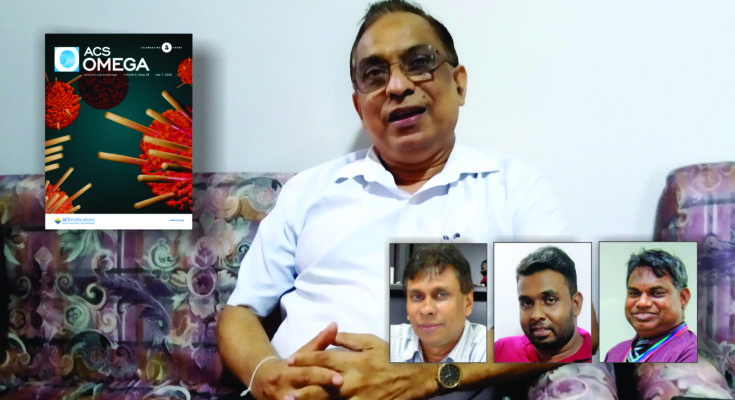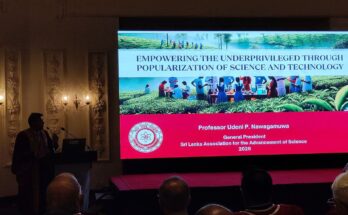A group of research scientists led by Prof. Chandana Udawatte from Sabaragamuwa University, has developed a novel method of producing Titanium Dioxide (TiO2) using locally available Ilmenite from mineral sand reserves in Pulmudai. The findings from this study were published in the Journal of American Chemical Society, ACS Omega.
Despite its small size, Sri Lanka is blessed with a treasure trove of mineral resources all around the island. These include precious gems, graphite with 99.9% purity, apatite reserves, mineral sand reserves and many more. Over the years these natural resources have played a large role in Sri Lankan economy as one of the main foreign income generators for the country.
Considered as one of the richest mineral sand deposits, Pulmudai mineral sand reserve is known for Ilmenite, Rutile and Zircon. Currently, Sri Lanka exports these minerals soon after mining and separation. Over 60% of the mineral sand deposit in Pulmudai are Ilmenite, while the other types of minerals available make up less than 20% in composition. Ilmenite is considered the most important ore of Titanium. Ilmenite is also the main source of Titanium Dioxide, which is used in paint, printing ink, fabric, plastic, paper, sunscreen, food and cosmetics.
For this research, Professor Udawatte and his team developed a novel method of producing Titanium Dioxide from Ilmenite. Talking to the Sri Lankan Scientist, Prof. Udawatte explained the importance of this work.
“We al know that we have a highly valuable natural deposit of mineral sands in Pulmudai, and over the years all we did was mine, separate and export these individual minerals in their raw form. We particularly export large quantities of pure Ilmenite every year. But if we can convert this to Titanium Dioxide, it would be a huge advantage for us as a country. A ton of Ilmenite is priced at 150 USD, while a ton of TiO2 is priced at 2250 USD, which is almost 15 times higher. This TiO2 is a raw material with a very high demand from industries like paint and ink.”
“During the 30 year war period scientists or chemists couldn’t go to Pulmudai to do any research on these minerals, but once the war ended many scientists and research groups (including ourselves) commenced investigations into possible value additions to these purified raw minerals. Our research team comprised of Professors Gamini Rajapakse and Rohana Chandrajith from the University of Peradeniya and Research Student Tharindu Rajakaruna’’.

“Two main processes have been used in extracting TiO2 from Ilmenite: namely, the Sulfate and Chloride processes. Both these conventional methods involve high temperatures that go up to 1000 ⁰C and usage of highly hazardous concentrated Sulfuric and Hydrochloric acids. Therefore, both the operational cost and environmental impact of these processes are remarkably high. “

“In this research, we were able to develop a novel method to extract pure nano scale TiO2 rods from this highly stable Ilmenite, cutting down the cost and environmental impact of the conventional method. Through this process we can do the TiO2 extraction using a low concentration of Hydrochloric Acid and comparatively low temperatures of around 170 ⁰C. As such, this process is more environmentally friendly and affordable for a country like Sri Lanka.’’
Speaking of possible applications of this method, Prof. Udawatte added, “At present we export raw ilmenite that are magnetically separated from the mineral sands for a low price. But if you can produce TiO2 and export that, we can generate more foreign income, which will be highly favorable for Sri Lanka’s economy. At the same time, we can market some of the by-products that are generated in this process, such as Hematite and zero valent Iron. We are also exploring the possibility of using this method for other minerals like Rutile and Zircon, to produce value added products.’’
Tharindu Rajakaruna, student member of this research team, explained the uniqueness of this method over the conventional methods. “In this process we had to begin the modification from the sand separation step itself. First, we developed a closed system for the separation process and changed the conditions used in magnetic separation to obtain the maximum purity in the ilmenite we separate. For the heating process, we used a rotating oven to increase the molecular interactions, which in turn eased up the TiO2 generation. We also had to add a post-reaction purification step to remove the small amounts of Silica that are trapped within the ilmenite crystal structure. With these modifications and changes, we could produce pure TiO2 nano rods from the ilmenite separated from mineral sands in Pulmudai.”

“Nano scale TiO2 is raw material for many industries and has very high demand in the global market. We have a great opportunity to exploit this huge demand if we start a commercial level production of nano scale TiO2.”

Apart from the mineral deposits in Pulmudai we have many other mineral resources around the island. Prof. Udawatte highlighted the responsibility of scientists to do research on value addition of these resources to maximize income generation to the country. “We can work towards erasing the country’s budget deficit with our mineral resources alone if we can come up with a good plan to add value to mineral products. Scientists in Sri Lanka have a big role to play as they are the ones who should come up with novel ideas. The government and private sector should then capitalize on these findings and get commercial level production started.”
Finally, Prof. Udawatte didn’t forget to thank all the institutes that helped them during this research. “Our research team is very thankful to all the institutes that supported this research, including Rajarata University, University of Peradeniya, Uwa Wellassa University, SLINTEC, Temple University in USA and Yamnashi University in Japan. All those universities and institutes helped us on different levels to carry out this research successfully.’’
Featured Image – Prof. Chandana Udawatte, and the cover page of ACS Omega (July 7, 2020, Volume 5, Issue 26) showing the Nano-rod structures of Titanium Dioxide produced using this novel method.
Special Thank goes out to Ashinsa De Silva Wijeyeratne on editing this write-up.




